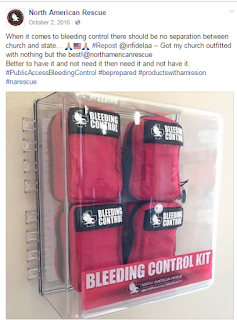 Why create and use a Business Continuity and Disaster Recovery Plan (BCDRP)?
Why create and use a Business Continuity and Disaster Recovery Plan (BCDRP)?
For the same reason you have a health plan, a car insurance plan, or a home owner’s policy...to prepare for, respond to, and successfully overcome a disaster. If you experience a major disaster, and man-made and natural disasters happen daily, having a BCDRP may make the difference between your business surviving or going out of business.
As importantly, having one may mean the difference between who lives and who dies. Think of it as life insurance YOU write that helps ensure that you, your loved ones, your employees, and your business go on.
What follows are some of the major parts of any BCDRP. It is only a guide.
Every BCDRP must be custom written and tested to your unique needs and circumstances. Use this for ideas of how to create your plan, but make sure you create a plan that reflects your needs.
Disaster Management Plan Purpose
The purpose of the BCDRP is to ensure that a clearly define BCDRP structure and accountable and responsible Disaster Management Team is in place to quickly, efficiently and effectively recognized and respond to any business disruption to:
- Ensure the safety of our employees and the security of our property
- Coordinate continuity of high quality service to customers
- Coordinate communication (both external and internal)
- Prioritize recovery efforts
- Activate the BCDRP
- Invoke emergency authorization to procure and allocate resources and support

What is a Disaster
- · Anything that causes harm to people or significant damage to property
- Anything that adversely affects the value or financial survival of the company
- Anything that disrupts routine business
operations or wastes significant management time or financial resources
Any good BCDRP includes the following tested and proven principles:
- Describe the business impact
- Identify impacted stakeholders
- Identify who does what and when
- Do not use overly technical information
- Provide an escalation point for issues and concerns
- Test the plan and incorporate lessons learned for future plans
In addition, here are some fundamentals your basic plan should cover:
- Develop and practice a contingency plan that includes a succession plan for your leadership.
- Train backup employees to perform emergency tasks. The employees you count on to lead in an emergency will not always be available.
- Determine off site disaster meeting places and disaster communication plans for all your employees.
- Practice disaster communication with employees, customers, suppliers and the outside world.
- Invest in an alternate means of communication in case the phone networks go down.
- Make sure that all employees are involved in the exercises so that they get practice in responding to an emergency.
- Make business continuity exercises realistic enough to tap into employees' emotions so that you can see how they'll react when the situation gets stressful.
- Form partnerships with local emergency response groups (firefighters, police and EMTs) to establish a good working relationship. Let them become familiar with your company and site.
- ·Evaluate your company's performance during each test, and work toward constant improvement.
- Conduct continuity and disaster recovery exercises
to reveal any changes and weaknesses. Technology, personnel and facilities are
in a constant state of flux at any company.
BCDR Plan Outline
 The most important fact about the BCDRP is that those who need the information can get it quickly, efficiently, and easily.
The most important fact about the BCDRP is that those who need the information can get it quickly, efficiently, and easily. One way to accomplish that goal is to separate the plan into two major sections: the plan itself and the material that supports the plan that goes into the appendix.
Here is a suggested outline that has worked well for many companies.
Disaster recovery planning is the process of creating a document that details how your business will recover from a catastrophic event. These steps include:
- Create a List of Jobs: Know all the office jobs that would have to be relocated to an alternate location.
- Create an Inventory Necessary Office Equipment: For each employee, list only the essential office equipment and furniture that they need to perform their jobs. Remember, in the event of a disaster, space, time and money will be at a premium.
- Create a Catalog of Supporting Software and Computer Equipment: Create a catalog of the essential office computer software and equipment you use.
- Identify an Alternate Office Space: Now that you have a list of people, furniture and computer software, networks and equipment, you will need a physical place to put them. Find several alternative places to relocate your office.
- Create an Insurance and Budget Document: After you decide where to put people, you will need to start buying them the stuff they need to do their jobs. Estimate how much each piece will cost to buy or lease. The time spent up front on this task will shave days off of the recovery process because you will be able to provide a list to your insurance agent of what you need.
- Share It and Store the Plan Off-site: Share your plan with several people and keep it in several places.
- See the table below for a suggested table of contents that should be included in any BCDRP.
Recommended BCDRP Table of Contents
See the table below for what material belongs in the appendix to the BCDRP. By organizing your document in this way it is easier to write, organize, and update.
Recommended BCDRP Appendix Sections
What
|
Description
|
Appendix A: Disaster Management Team Activation Guide
| |
Appendix B: Emergency Evacuation Procedure and Safe Assembly Areas
|
Instructions for when and how to evacuate and where to gather once out of the building.
|
Appendix C: Exit, Fire Extinguisher, Fire Alarm and Hose Locations
|
Description of how to exit the floor and building, and the location of the emergency equipment.
|
Appendix E: Shelter-in-Place Instructions
|
Instructions for when and how to shelter in place if necessary
|
Appendix F: Reporting Disasters
|
Instructions for how and to whom to concisely and accurately report disaster.
|
Appendix G: Floor Plan
|
Drawing of each floor with employee name, phone, and email on the drawing, along with clearly identified exits.
|
Additional Appendixes
|
Add any sections that are necessary to your plan.
|
Additional Tips
- Make a list of all your software you may need to replace.
- Back up all your files.
- Put your essential files of a thumb drive. You may need them to get restarted.

Increasing, using social media correctly to respond to a disaster is one of the most critical parts of your BCDRP. To ensure your social media presence is ready for a disaster, make sure that you:
- Have a media plan with the tools, skills and resources to promptly execute your media
- Have accounts with the right social media outlets (Facebook, Twitter, Instagram, etc.) before the disaster
- Monitor social media before, during and after the disaster
- Designate one employee to speak for the company through social media outlets because social media is driven by trust in people, not an organization
- The audience has the tools to investigate, record, and publish, so content accuracy is critical
- A good response should include negative perceptions and address causes and facts
- With your posts, tweets, photos etc. a link with more information will always help support your message

Disaster Management Team Roles and Responsibilities
When the Incident Commander convenes the Disaster Management Team (DMT), he or she also authorizes the BCDRP and declares an emergency. Each member of that team has specific responsibilities that are listed below.
Core DMT Roles and Responsibilities
Role
|
Responsibilities
|
Incident Commander
|
Leads the CMT. Provides guidance to the team and is the final decision maker in the case of conflict or lack of consensus.
|
CMT Coordinator
|
Assembles the team at the request of the Incident Commander. Schedules meetings, assists with meeting facilities and general support, and completes additional tasks requested by the Incident Commander. Informs other levels for the Incident Commander.
|
CMT Member
|
Participate in discussion and take ownership of actions to ensure resolution of issues within their area of expertise.
|
Note Taker
|
Documents all CMT meetings to capture discussion points, actions, owners and deadlines.
|
Social Media Liaison
|
Social media expert who has preexisting accounts on social media platforms who professionally and accurately communicate with external and internal customers.
|
Trusted Advisor
|
Provides detailed specialized knowledge to provide additional capacity.
|
Tabletop Exercise
 Every BCDRP requires a test to prove that it works and to identify areas that need improvement, also known as a tabletop exercise. Each participant undertakes the actions and tasks as they would during a real disaster.
Every BCDRP requires a test to prove that it works and to identify areas that need improvement, also known as a tabletop exercise. Each participant undertakes the actions and tasks as they would during a real disaster. After the exercise, the team members identify the plan strategies that worked and did not work. Then they identify and implement actions that improve the plan, including adding them to the plan.
For the best tools of the trade, see North American Rescue.











